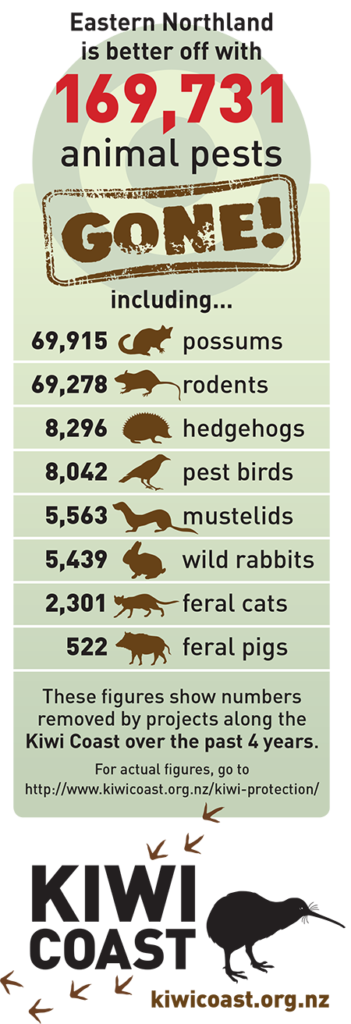Projects involved in the Kiwi Coast have removed a staggering 169,731 pests from Northland over the last four years.
 For the fourth year in a row, Kiwi Coast projects pooled their trap-catch data, demonstrating the power of working together and the impact being had on Northland’s predators.
For the fourth year in a row, Kiwi Coast projects pooled their trap-catch data, demonstrating the power of working together and the impact being had on Northland’s predators.
Since 2013 the collaboration of community, iwi, hapu and agency led projects have destroyed 169,731 animal pests including: 69,915 possums; 69,278 rats; 5,563 mustelids; 8,296 hedgehogs; 5,439 wild rabbits; 2,301 feral cats; 8,042 magpies and myna’s and 522 feral pigs. Individual tallies of pest species are kept on the Kiwi Coast Pest Control Results Table and updated each year.
In 2016 alone, a total of 56,629 animal pests were trapped, meaning that every week over 1000 pests are being removed from the Kiwi Coast.
Collectively Kiwi Coast groups are trapping animal pests over 125,217 ha, making it New Zealand’s largest pest control project.
The effects of the landscape-scale pest control are evident in the flourishing native forests, increasing kiwi numbers and the return of birdsong to near silent areas where pests are being controlled to low levels.
Kiwi Coast Coordinator Ngaire Tyson says “Northland communities are working hard to reduce animal pests and help our forests and native wildlife thrive. Working together we are making a real difference on-the-ground where it matters most.”
The Kiwi Coast vision of creating New Zealand’s first kiwi corridor, where thriving kiwi can roam safely across Northland from one safe area to another, gets closer every year as communities lead the charge to not just reverse the decline of kiwi but ensure they flourish forever.
Working together as the Kiwi Coast, more than 80 groups and projects in Northland are collectively carrying out pest control from Mangawhai to the Aupouri peninsula leaving a huge dent in animal pest populations in their wake.
More than just impressive numbers, the pooled pest control data are the real results recorded from actual trap checks from all the groups involved. The shared pest results represent thousands of hours of trap checking each year by a mix of unpaid and professional trappers working hard to reduce animal pests so native wildlife can thrive.
Some of the groups involved in the Kiwi Coast have been operating for almost two decades and have successfully created biodiversity strongholds on both public and private land. The Kiwi Coast works to link up and connect predator control networks of individual projects together to maximise efficiencies and increase the ecological effects gained by working at a landscape scale.
The Department of Conservation’s Northland Kiwi Call Count for 2014 showed that overall kiwi are increasing at a slow and steady rate at sites along the Kiwi Coast where predators are controlled to low levels. This bucks the national trend identified by the Kiwis for Kiwi Trust of a nationwide decline in kiwi of 2% per year. In fact, monitoring shows that kiwi populations have more than doubled at a number of sites on the Kiwi Coast.
“As ferrets and stoats can devastate kiwi populations, removing 5,535 mustelids from the Kiwi Coast over four years is a huge part of keeping Northland kiwi numbers going up. It’s crucial now to sustain this momentum and keep it going!” Ngaire says.
To get involved in the Kiwi Coast or find out how to submit pest control results for your area contact Ngaire the Kiwi Coast Coordinator.



